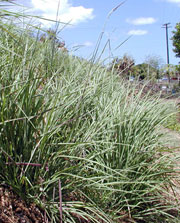
|
In The Garden
Rick Barboza
|
Clinging pili grass is used for thatch
Pili grass
Heterogpogon contortus
Description: Pili grass forms bunches or tufts of light blue-green leaf blades, ranging from 2 to 3 feet tall. Flowers form spikelets at the top of the plant and often become tangled. The dense cluster of seeds that results is most likely the source of the plant's name: The word "pili" means to stick or cling to.
 HUI KU MOALI OLA
Pili is available at Hui Ku Maoli Ola for $2.50 each.
|
|
Distribution: Pili grass is an indigenous plant, or perhaps a Polynesian introduction, found in dry open areas, rocky cliffs or slopes near the ocean. It grows throughout the tropics, including all the main Hawaiian islands, in scattered populations. An interesting side note is that many of the Great Plains states use pili when restoring their grasslands and prairies. It is probably safe to say that more pili grass is growing in those states than in Hawaii.
Cultural uses: Pili was used primarily for thatching houses, and continues to be used that way today. It was also placed on hula altars in hopes that newly gained knowledge would pili, or stick in the dancers' minds.
Landscape use and care: Full sun in hot, dry areas is best. Pili is easy to care for, requiring little watering, if any. Few pests bother this plant, although birds often prune off blades for nesting material.
Pili grass is available at my nursery, Hui Ku Maoli Ola in Kaneohe. I even have a large planting of it on a hillside to control erosion, for which it is excellent. That planting serves as a great example of how it will appear when fully grown in your yard.
Note: This is probably what the "Little Grass Shack (in Kealakekua, Hawaii)" was made of. It could also be the material used in building the "Love Shack," since the word "pili" also means together, to be with, adhere to, join, etc. -- words often associated with lovers.
The phrase "pili aloha" means close friend or beloved companion, so rather than giving your significant other a dozen roses, give her/him a bunch of pili grass to show how much you care. Just make sure you explain the meaning behind it.
Rick Barboza co-owns Hui Ku Maoli Ola, a native Hawaiian plant nursery, with Matt Schirman. Contact him at 295-7777 or e-mail
Rick.CK.Barboza@gmail.com

